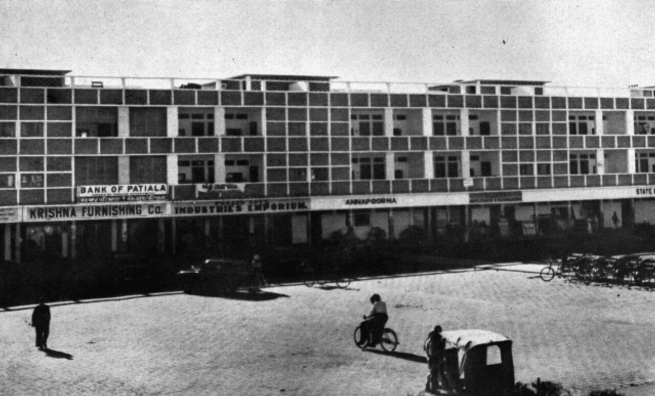Following the partition of the subcontinent in 1947, India’s first Prime Minister Pandit Jawaharlal Nehru announced that the freshly severed state of East Punjab would have a new capital city. His decision to build a new capital, rather than adopt an existing city, was both practical and symbolic for the rehabilitation of Punjab, which had suffered the greatest trauma and violence from partition. This new capital would be a “modern” city, and the site was selected in mid-1949: a plain 180 miles north of Delhi. Twenty-four villages and 9000 residents were forced to give up their land and relocate, and the soon-to-be-built city of Chandigarh was named after one of the existing villages, which had a temple dedicated to the Hindu goddess Chandi.
At the inaugural ceremony of Chandigarh, Nehru proclaimed, “Let this be a new city, unfettered by the traditions of the past, a symbol of the nation’s faith in the future.” Chandigarh was to reflect the aspirations of a freshly independent nation; there was no room for nostalgia. As the art historian Vikramaditya Prakash perceptively notes, “Nehru’s Chandigarh was not meant to be a prophecy of the future…but was intended as an expression of faith in the future—the belief that the modern way of thinking and doing things would allow the future to emerge.”
The task of realizing Nehru’s vision fell to a group of functionaries of the state and politicians who trusted Western models and professionals to lead the way. The crucial choice to organize Chandigarh according to an early twentieth-century English utopian urban planning model was made by the first bureaucrat put in charge of the project, A.L. Fletcher. U.S.-based architect-planners Albert Mayer and Matthew Nowicki were hired. However, after Nowicki’s unexpected death in 1950, the Swiss-French architect Le Corbusier was appointed. Corbusier worked with a team comprised of his cousin Pierre Jeanneret, Maxwell Fry, and Jane Drew, assisted by a further design cohort of nine Indian architects and planners—M.N. Sharma, A.R. Prabhawalkar, B.P. Mathur, Piloo Moody, U.E. Chowdhury, N.S. Lamba, Jeet Lal Malhotra, J.S. Dethe, and Aditya Prakash.
Corbusier would personally draw up the Master Plan for Chandigarh, as well as the vast Capitol Complex where the major institutions of state were to be located, containing the High Court, Legislative Assembly, Secretariat, and the Governor’s Residence (though this last structure remains unbuilt). He would also prepare the guidelines for the commercial center, and in an adjoining sector, design a museum and school of art. The rest of the team worked on the majority of the other buildings within the city, with Jeanneret assuming a very active role because he lived in India for three years; Corbusier flatly refused to do so, and would only visit the country twice a year, for one month at a time.
Ground was broken in September 1951 and since then Chandigarh has been incessantly filmed, and in particular Corbusier’s buildings. My program for Light Industry gathers together a generically heterogeneous group of lesser-known films on Chandigarh. Historical material includes the state-funded polemical short, simply titled Chandigarh by the Films Division of India, and Alain Tanner’s humanist documentary Une Ville à Chandigarh, narrated by John Berger. Both films contain valuable archival footage of the capital being built and dwell on the ideological possibilities engendered by the urban project in daily life, and each is very much informed by the differing political agendas and currents of the mid-twentieth century.
The more contemporary material shifts focus away from the familiar Corbusier-centered narrative. An excerpt from Channel 4’s three-episode series Journeys into the Outside with Jarvis Cocker follows the eccentric Pulp lead singer as his visits the outsider artist Nek Chand, whose Rock Garden, situated south of the Capitol Complex, is more popular with local visitors than Corbusier’s buildings. Chand single-handedly assembled the garden over a thirty-year period, filling it with thousands of unusual human and animal forms made from waste generated by the construction of Chandigarh. Surabhi Sharma’s Tracing Bylanes is a present-day reflection on the current state of the planned city, how it is occupied and claimed by the inhabitants.
Nalini Malani’s recently re-discovered double-channel projection Utopia serves as a coda for the program. Malani completed the animated component of the piece when she was a member of the Vision Exchange Workshop in Mumbai (set up by the Indian painter Akbar Padamsee) in the late 1960s. Inspired by Johannes Itten’s color theories, and the photographic experiments and Light-Space Modulator of László Moholy-Nagy, Malani built a model townscape from thick black paper, and under varying slants of light photographed it from a crane-like perspective. These photographs were then converted into large negatives from acetate sheets with registration holes. The gray tones were changed into color by using color filters, and the acetate sheets were finally shot individually on 16mm. The second, black-and-white part of the work, in which a young woman looks out of a window, and onto which the animation is superimposed, was filmed in 1976 after Malani had returned from a scholarship in Paris. Utopia is not simply a formal study, but a pulsating confrontation with modernist architecture and its utopian potential, through which Malani effectively brings into sharp and pointed consideration the unsettling urban landscape of post-independence India.
When seen together, these films, made by both Indian and Western artists, expose the myriad and competing desires that fueled the inception of the city, as well as those which have continually been projected onto it. The collection will also hopefully help expand the image of Chandigarh in the public imaginary—which has long been limited to Corbusier’s architecture, today often cast as a set of well-worn, camera-ready ruins—and bring the greater, living city of Chandigarh into view. This program intends to remind us that Chandigarh is in India, and is not and has never only been merely a stage set for Corbusier’s modernist magnum opus.
Programme notes by Shanay Jhaveri



